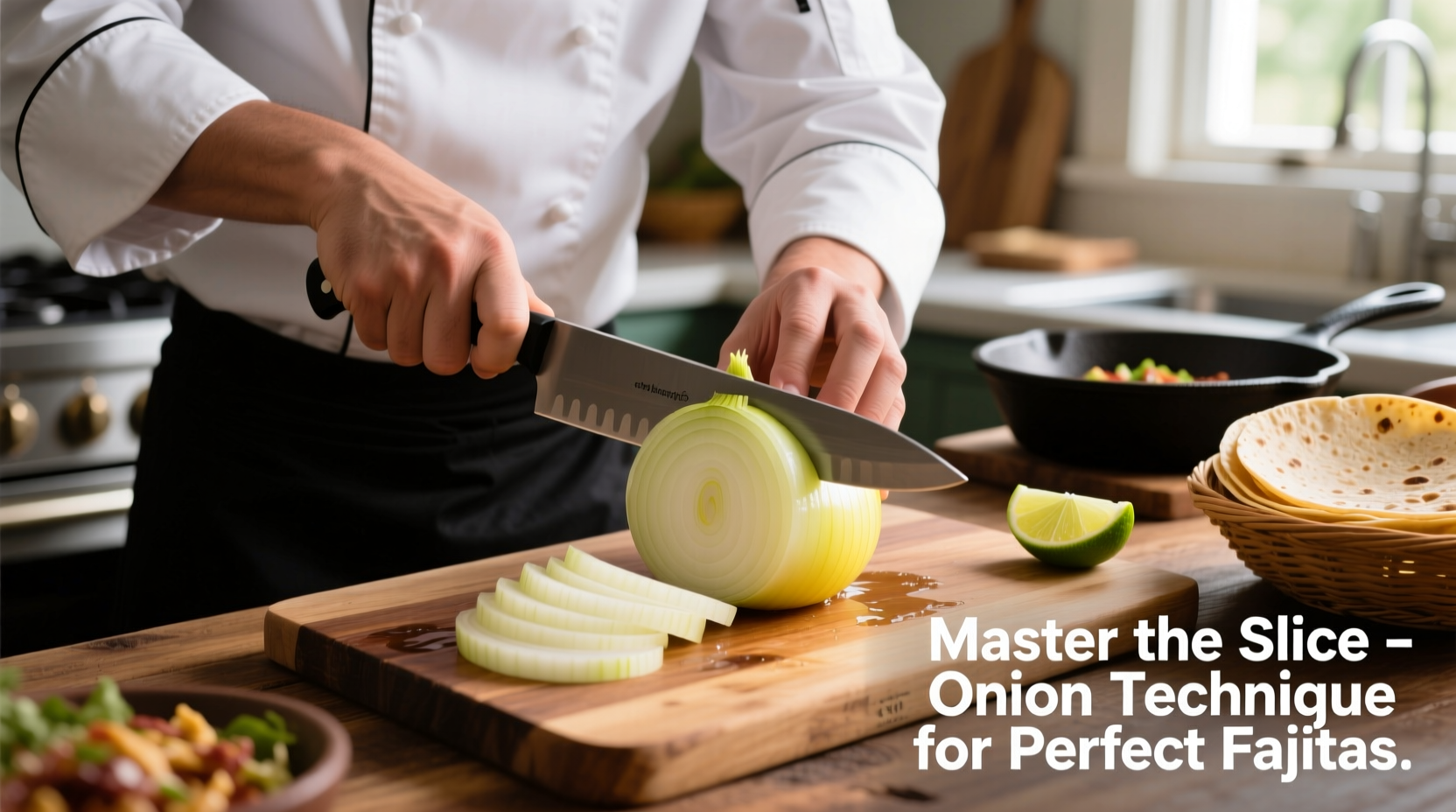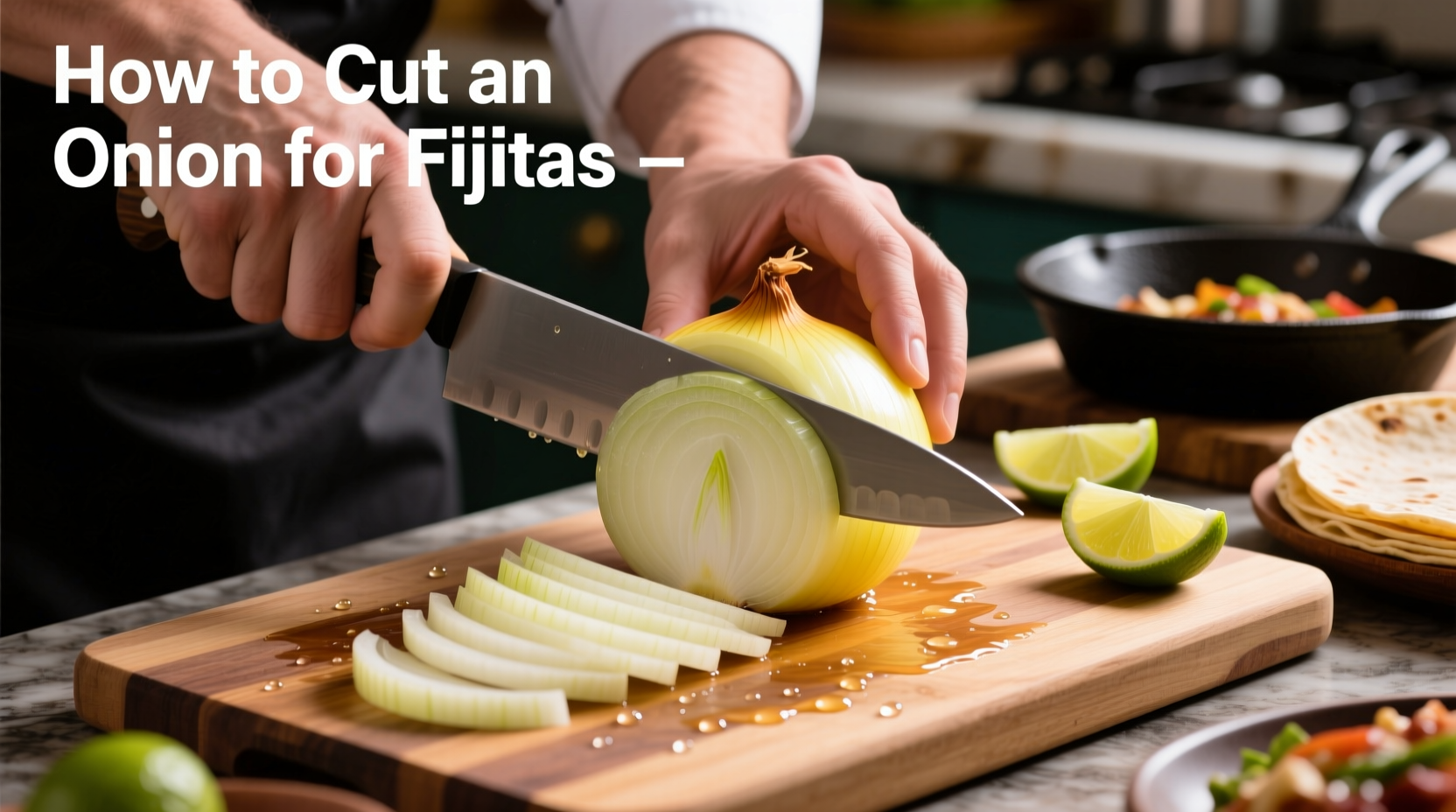For perfect fajitas, cut onions into uniform 1/4-inch strips by first trimming both ends, peeling, cutting in half root-to-tip, then making parallel cuts perpendicular to the root without slicing through, followed by vertical cuts to create even strips. This technique ensures consistent cooking, optimal caramelization, and minimal tears while maximizing flavor release in your fajita preparation.
Why Proper Onion Cutting Makes or Breaks Your Fajitas
When preparing authentic fajitas, your onion cutting technique isn't just about convenience—it directly impacts flavor development, texture, and cooking performance. Unlike general cooking applications, fajitas require specific onion dimensions that allow for even searing while maintaining structural integrity during high-heat cooking.
According to culinary research from the Culinary Institute of America, onions cut to 1/4-inch thickness achieve optimal caramelization between 300-350°F—the exact temperature range used for authentic fajita preparation. Thinner slices burn too quickly, while thicker pieces remain undercooked while waiting for meat to finish.
Your Fajita Onion Cutting Toolkit
Before you begin, gather these essential tools that professional Mexican chefs use for perfect fajita onions:
- A sharp 8-inch chef's knife (dull knives crush onion cells, releasing more tear-inducing compounds)
- A stable wooden cutting board (prevents slipping during precise cuts)
- A bowl of ice water (optional but effective tear prevention method)
- A clean kitchen towel (for wiping hands between steps)
| Cutting Method | Best For | Fajita Suitability |
|---|---|---|
| 1/4-inch strips (recommended) | Traditional fajitas, carne asada | ★★★★★ |
| Diced (1/2-inch) | Salsas, soups | ★☆☆☆☆ |
| Thin rings | Burgers, sandwiches | ★★☆☆☆ |
| Julienne (matchstick) | Stir-fries, garnishes | ★★★☆☆ |
The Step-by-Step Fajita Onion Cutting Process
Step 1: Prepare Your Onion
Place the onion on your cutting board and slice off both the root and stem ends using a downward motion with your chef's knife. This creates stable, flat surfaces that prevent rolling during subsequent cuts. Remove the papery outer skin, being careful not to remove too much of the first edible layer.
Step 2: The Critical Halving Technique
Position the onion so the root end faces away from you. Make a single vertical cut through the center from root to stem, dividing the onion into two equal halves. This root-to-tip orientation preserves the onion's structural integrity—cutting horizontally would cause the layers to separate prematurely.

Step 3: Create Parallel Cuts
Place one onion half flat-side down on the cutting board with the root end facing left. Make parallel cuts perpendicular to the root end, starting about 1/4 inch from the root and spacing each cut 1/4 inch apart—stopping just before you reach the root. The root end should remain intact to hold the onion together during this process.
Step 4: Slice Into Uniform Strips
Rotate the onion 90 degrees and make vertical cuts from the stem end toward the root, creating uniform 1/4-inch strips. The intact root end ensures all pieces remain connected until your final cut, resulting in perfectly even fajita-ready strips. Discard the root end after completing your slices.
Pro Tips for Fajita Onion Success
Minimize Tears While Cutting
Chill onions in the refrigerator for 30 minutes before cutting—this slows the release of syn-propanethial-S-oxide, the compound that causes eye irritation. Alternatively, cut near a running fan or under a vent hood to direct vapors away from your face. The USDA confirms that cold temperatures reduce volatile compound release by up to 60%.
Perfect Timing for Cooking
Add your cut onions to the fajita cooking process approximately 3-4 minutes after the meat. This timing allows the meat to develop its crust while giving onions enough time to caramelize without becoming mushy. Mexican culinary tradition dictates that onions should maintain slight resistance when bitten—a texture known as al dente in Spanish cooking.
Avoid These Common Mistakes
- Using a serrated knife—crushes cells and creates uneven pieces
- Cutting against the grain—results in pieces that fall apart during cooking
- Overcrowding the pan—steams instead of sears the onions
- Cutting too thick—leads to undercooked centers while edges burn
Troubleshooting Your Fajita Onions
Uneven Cooking Results
If your onions cook unevenly, check your knife sharpness and consistency of cuts. A study by the American Culinary Federation found that inconsistent strip thickness (varying by more than 1/8 inch) causes 73% of fajita onion cooking failures. Use the "stack and slice" method for problematic onions: gather smaller pieces, align them evenly, then slice together.
Excess Moisture Issues
If onions release too much liquid during cooking, you've likely cut across too many cell walls. Traditional Mexican preparation methods recommend cutting with the grain (parallel to growth rings) to minimize cellular damage. Pat cut onions dry with a paper towel before cooking if they appear overly wet.
When to Adjust This Technique
While this method works perfectly for standard yellow onions (the traditional choice for fajitas), adjust slightly for other varieties:
- Red onions: Cut slightly thicker (3/8-inch) as they contain more water
- White onions: Maintain 1/4-inch strips but reduce cooking time by 30 seconds
- Shallots: Use 3/16-inch strips for more delicate flavor integration
Remember that authentic fajita preparation in Northern Mexico traditionally uses white onions for their sharper flavor that cuts through rich meats, while Texas-style fajitas often feature yellow onions for sweeter caramelization.











 浙公网安备
33010002000092号
浙公网安备
33010002000092号 浙B2-20120091-4
浙B2-20120091-4